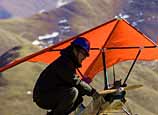
Excessive land reclamation and flood irrigation are accelerating the lake's desertification.
"Ten years ago, we could get a water well by digging several meters underground, now we have to dig more than 100 meters," said Huang Faxin, deputy head of the Lake Aibi Wetland National Nature Reserve Administration.
He said only two out of 11 rivers that used to feed into the lake continue to provide it with water.
A large area of land is being reclaimed around the reserve and at the upstream of the rivers. As a result, the flow of water into Lake Aibi is slowing dramatically.
Farmers are using more water than they need in choosing flood irrigation instead of water-saving trickle irrigation, because the latter measure is more expensive.
"For every hectare of land reclaimed, the lake will shrink 2.25 square km," said Huang. "In another 10 years, the eight farms scattered around the lake basin and hundreds of thousands of hectares of land will no longer exist and more than 300,000 people have to leave their homeland."
ENVIRONMENTAL PROTECTION MEASURES
Local authorities built 12 cofferdams in the region in 2007 to gather water from surrounding areas. Some 15,000 mu (1000 hectares) of dry earth is now covered with vegetation.
Water conservation projects have been applied to the Jinghe and Daheyanzi rivers, along with tree and grass planting initiatives in their lower reaches.
















 Landmark building should respect the public's feeling
Landmark building should respect the public's feeling


![]()
